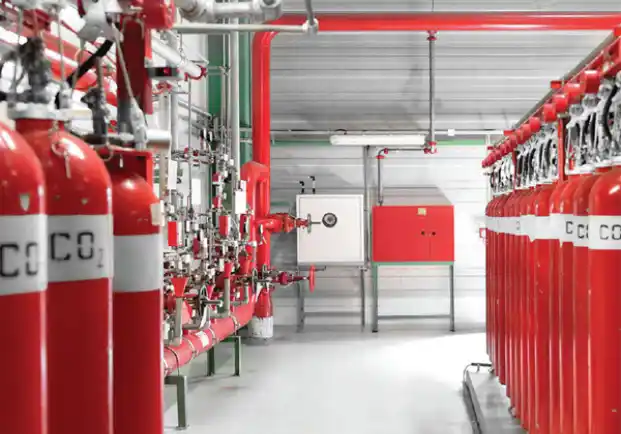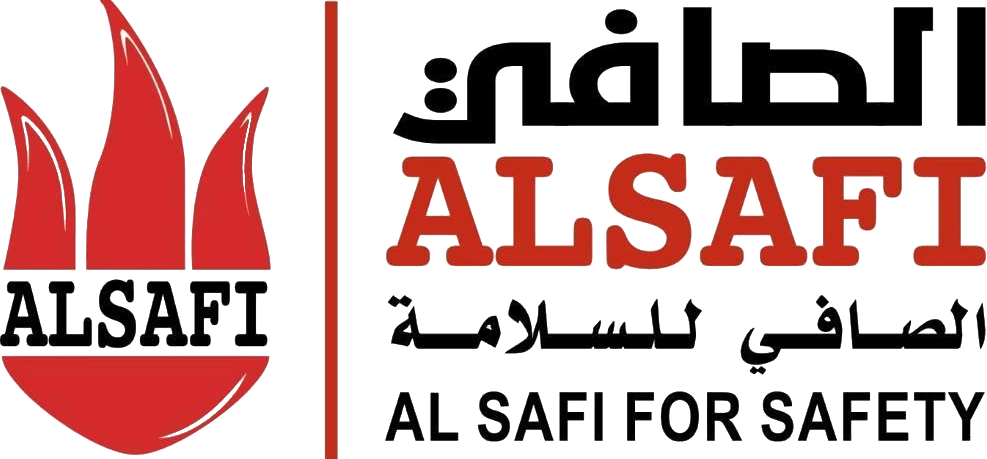How to use a CO2 fire extinguisher and its proper mechanism of operation

When it comes to protecting human and material resources in facilities from fire risks, a CO2 fire suppression system is an ideal option. It provides an advanced solution that combines safety and efficiency, making it perfect for areas containing sensitive devices and electronic equipment.
In this article, we explain how to use a CO2 fire extinguisher by outlining its operating mechanism, advantages, and more.
What is a CO2 fire suppression system?
Carbon dioxide is a nonflammable gas and a poor conductor of heat, which makes it effective for controlling fires. A CO2 fire suppression system can extinguish fires without causing property damage, and it requires no cleanup after suppression.
The CO2 system works by releasing a quantity of CO2 gas that reduces oxygen—an essential element that sustains combustion—thereby helping extinguish the fire effectively.
CO2 extinguishers are available in different sizes, so it’s best to consult specialists to determine the most suitable size to protect your property effectively.
Why don’t CO2 extinguishers have gauges?
At about 55 bar and 20°, fire extinguishers are filled with carbon dioxide, which becomes a liquid state known as liquefied CO2—and sometimes dry ice. This liquid turns to gas as soon as there is space for expansion.
When the extinguisher is used, any released gas is replenished by converting an equivalent amount of liquid to gas, which keeps the pressure inside the cylinder constant for this reason.
Installing a pressure gauge on these extinguishers is not useful, as the liquid remains stable. The only way to check a CO2 extinguisher’s contents is to periodically measure its weight.
What are the benefits of using a CO2 extinguisher?
Here are the benefits of using a CO2 fire extinguisher:
- Effective on gas and liquid fires: Carbon dioxide is nonflammable and smothers the fire by removing oxygen, making it particularly effective for gas and liquid fires that require heat reduction or oxygen removal to extinguish.
- Safe for sensitive environments: CO2 is nonflammable and non-toxic, making it safe to use in sensitive environments such as laboratories and hospitals.
- No residue after use: CO2 evaporates quickly after use and leaves no residue, which is ideal for environments that must remain clean, such as offices and kitchens.
How a CO2 fire suppression system works
A CO2 system operates on a simple, effective principle focused on reducing oxygen at the fire location, which extinguishes the fire quickly and efficiently. Here’s how it works:
- Fire detection: The system begins with detection via advanced sensors that monitor changes in temperature and smoke. When a fire is detected, the system sends signals to activate the suppression cycle.
- CO2 discharge: CO2 is stored in cylinders under high pressure. When the system is activated, gas is released through piping to the fire area.
- Oxygen reduction: Upon release, the gas quickly moves into the burning area, displacing oxygen. Since oxygen is essential for combustion, replacing it with CO2 reduces the fire’s ability to continue.
- Protecting the area: CO2 extinguishes flames without damaging equipment or devices because it leaves no residues or additional materials. This makes it ideal for electronics and sensitive systems that cannot tolerate traditional extinguishing agents.
- Ventilation and safety check: After extinguishment, the area must be well ventilated to remove any remaining CO2 and restore oxygen to normal levels before people re-enter.
Which fire types should be fought with CO2?
It is preferable to use fire-fighting equipment based on CO2 to combat large fires caused by flammable materials; these extinguishers are described as suitable for Classes A, B, and C.
Examples include electrical fires, fires from liquid storage, and warehouse fires involving engines.
Advantages of a CO2 fire suppression system
Using a CO2 extinguisher offers several advantages, especially in spaces with sensitive devices and electronics. Key benefits include:
- High effectiveness: CO2 systems quickly extinguish fires by reducing oxygen at the fire site, stopping combustion immediately.
- Safe for electronics: CO2 does not conduct electricity, making it safe where electrical systems and electronics are present.
- Instant cooling: In addition to extinguishing, CO2 cools the affected area, helping prevent re-ignition.
- Environmentally friendly: When used for fire suppression, CO2 does not cause major environmental harm; it evaporates quickly and leaves no harmful residues.
- Broad coverage: Suitable for many locations—factories, laboratories, server rooms, and commercial centers—making it a comprehensive solution for various fire types.
How to use a fire extinguisher
For a small fire, you can use an extinguisher safely by following these steps:
- Pull the pin or seal that prevents accidental use—this readies the extinguisher.
- Aim at the base of the fire, not the flames, since that’s where combustion starts.
- Squeeze the handle firmly and steadily to discharge the agent.
- Sweep the nozzle side to side to cover as much of the fire area as possible.
The best company to buy a CO2 extinguisher
If you want to purchase a CO2 fire extinguisher, Al-Safi is an ideal choice because:
- They provide a wide variety of extinguishers to suit different facility needs and fire types.
- A trained team delivers high-quality installation and maintenance services.
- They offer competitive prices compared to other companies.
That concludes our article on using fire extinguishers. Don’t hesitate to contact Al-Safi to obtain CO2 extinguishers—an ideal solution for fast, effective fire suppression that protects lives and property.
Frequently asked questions about using a CO2 extinguisher
Why is carbon dioxide used in fire extinguishers?
CO2 helps stop fuel combustion quickly. When a fire breaks out, it can be suppressed faster, reducing damage to property and people.
Why is the CO2 extinguisher hose different from others?
Because the gas is stored as a liquid under pressure, the specialized hose helps release the gas and contain the fire.
What are the disadvantages of CO2 extinguishers?
They are less environmentally suitable than some other types since they displace oxygen with carbon dioxide, which can cause asphyxiation if used in confined spaces.



